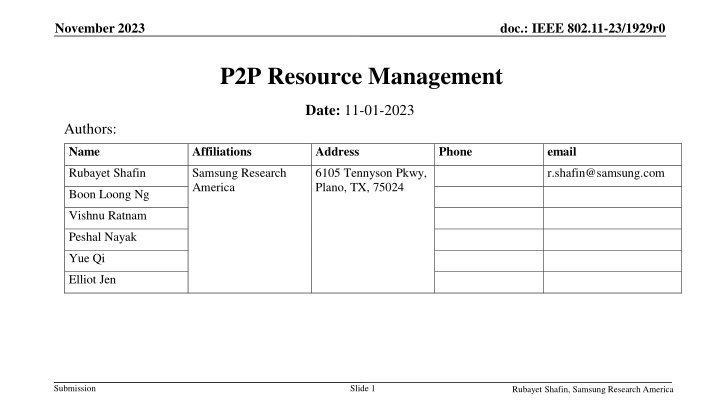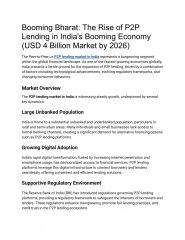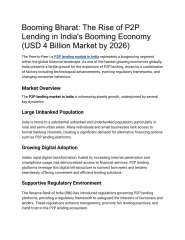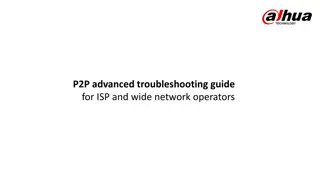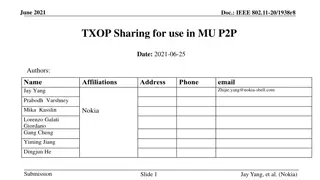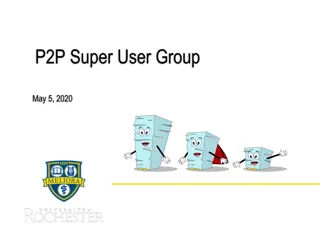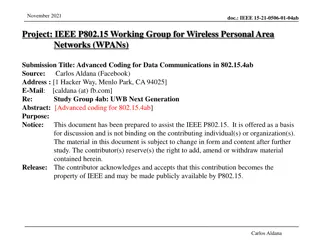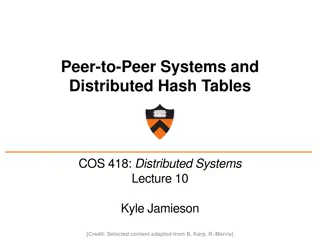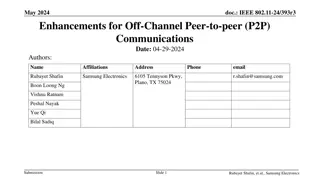Enhancing P2P Resource Management in IEEE 802.11 Networks
Discussion on improving P2P communication efficiency on base and off-channels in IEEE 802.11 networks, focusing on enhancements for better interaction between WLAN network and P2P groups. Emphasizes the importance of involving AP in QoS provisioning for P2P communications and proposes mechanisms to assist P2P operations on off-channels. Current challenges and potential technologies for efficient P2P communication are highlighted.
Download Presentation

Please find below an Image/Link to download the presentation.
The content on the website is provided AS IS for your information and personal use only. It may not be sold, licensed, or shared on other websites without obtaining consent from the author.If you encounter any issues during the download, it is possible that the publisher has removed the file from their server.
You are allowed to download the files provided on this website for personal or commercial use, subject to the condition that they are used lawfully. All files are the property of their respective owners.
The content on the website is provided AS IS for your information and personal use only. It may not be sold, licensed, or shared on other websites without obtaining consent from the author.
E N D
Presentation Transcript
November 2023 doc.: IEEE 802.11-23/1929r0 P2P Resource Management Date: 11-01-2023 Authors: Name Affiliations Address Phone email Rubayet Shafin Samsung Research America 6105 Tennyson Pkwy, Plano, TX, 75024 r.shafin@samsung.com Boon Loong Ng Vishnu Ratnam Peshal Nayak Yue Qi Elliot Jen Submission Slide 1 Rubayet Shafin, Samsung Research America
November 2023 doc.: IEEE 802.11-23/1929r0 Abstract In this contribution, we discuss possible enhancements for improved P2P communication on the base channel (i.e. the channel on which the associating infrastructure AP operates) Submission Slide 2 Rubayet Shafin, Samsung Research America
November 2023 doc.: IEEE 802.11-23/1929r0 Introduction P2P communications, for most consumer devices, can be categorized based on types of operating channels Base-channel P2P: When the P2P clients operate on the channel where the infrastructure AP operates. Off-channel P2P: When the P2P clients operate on the channels different from the AP s channel. A P2P device with concurrent operation (i.e. a device that operates in a P2P group and also is a member of a WLAN network) typically switches between the base channel and the off-channel(s). The dwelling time in the base channel and the off-channel for P2P communication is roughly equal. With the increased network load and the demand for low-latency, high-throughput P2P traffic, it is important to improve the P2P operation efficiency in both the base channel and the off-channel. In [3], [4], we highlighted some of the possible mechanisms to assist P2P operation on the off-channels by enhancing baseline Channel Usage and Peer-to-Peer TWT features. Most work still needs to be done to better facilitate the base-channel P2P operation. Submission Slide 3 Rubayet Shafin, Samsung Research America
November 2023 doc.: IEEE 802.11-23/1929r0 Motivation Efficient and effective Peer-to-peer (P2P) communication is extremely important for various applications. In [1],[2], we highlighted some of the potential technologies for improved peer-to- peer (P2P) operation. At present, AP is essentially hands-off for any P2P communication in the network. (latency-sensitive) (latency-sensitive) In a congested network, this may inhibit the timely delivery of P2P traffic For base-channel P2P operation, the AP should be involved in QoS provisioning for P2P communications for non-AP STAs. Example scenario for latency-sensitive P2P traffic between the HMD and the companion device. AR/VR/XR are typical application scenarios. In this contribution, we highlight some aspects of how to improve the interaction between the WLAN network and P2P groups. Submission Slide 4 Rubayet Shafin, Samsung Research America
November 2023 doc.: IEEE 802.11-23/1929r0 Existing P2P-Infra interaction AP Currently, any assistance from the infrastructure AP for P2P communication is on a per-STA basis. TXOP STA1 (GO) When a TXOP is allocated to a STA for P2P, only that STA can utilize the TXOP for transmitting to its peer. If the TXOP-recipient STA intends to receive frames from its peer device during the TXOP allocated by the AP, then the TXOP recipient STA can transition to a role of mobile AP in order to solicit the transmission from the peer STA, which again is in a per-peer-STA basis. This is illustrated in the figure where STA1 is associated with the infrastructure AP and receives a TXOP from the AP. STA1 then assumes the role of a mobile AP and allocates a portion of the TXOP to facilitate the transmission from STA3, which might not be associated with the same (or any) infrastructure AP. This process naturally increases the latency as the P2P group size increases. TXOP STA2 STA3 STA4 STA5 P2P Group Figure:AP s TXOP usage in a P2P group: (possible with IEEE + Non-IEEE combination) Submission Slide 5 Rubayet Shafin, Samsung Research America
November 2023 doc.: IEEE 802.11-23/1929r0 Need for Group-based resource allocation P2P devices typically operates in a group or cluster-basis For various evolving applications such as interactive XR experiences, members of a P2P group/cluster may have the same or very similar traffic pattern (and the traffic can also be latency-sensitive). To better support the P2P communication within the overall P2P group/cluster, the AP should be able to allocate its resources in a per-group/cluster basis. AP P2P Group-A P2P Group-B Submission Slide 6 Rubayet Shafin, Samsung Research America
November 2023 doc.: IEEE 802.11-23/1929r0 An illustrative example AP Consider the scenario depicted in the figure where the AP is aware of the resource requirement for a P2P group, and makes scheduling decision to allocate resources for the group. STA1 (GO) Subsequently, the AP obtains a TXOP and allocates it to the P2P group. This TXOP can be allocated by sending a trigger frame. The functionality of the trigger frame can be similar to MU-RTS TXS trigger frame with additional enhancements. STA2 STA3 STA4 PPDU(1) Members of the P2P group, for their P2P transmission within the group, can utilize a portion of the TXOP allocated to that group by the infrastructure AP. STA5 P2P Group Submission Slide 7 Rubayet Shafin, Samsung Research America
November 2023 doc.: IEEE 802.11-23/1929r0 Mechanisms needed for interacting with P2P groups In the previous slides, we highlighted the need for AP s provisioning of resources on a P2P group basis in order to better support enhanced multi-device experience. However, the infrastructure AP currently does not recognize P2P group . Group Identification: To better assist resource allocation, we need a mechanism so that the AP can identify a P2P group A peer STA can inform the AP about its affiliation with a P2P group either Explicitly (TBD), or Implicitly (for example, by sharing a common traffic flow) (TBD) Resource Solicitation: A procedure would be needed to solicit resources from the AP for a P2P group accounting for the needs of other members. This would make the AP aware of the resource needs of the members of that P2P group Resource Delivery: Some additional enhancements are needed to ensure that the AP can effectively deliver the resources to the P2P group and the members of the P2P group can access the resources. Submission Slide 8 Rubayet Shafin, Samsung Research America
November 2023 doc.: IEEE 802.11-23/1929r0 Summary Enhanced P2P communication can be pivotal for various applications, for example, for truly immersive AR/VR/XR experiences. Enhancements are needed to improve both the base channel and off-channel P2P communication. In this presentation, we discuss aspects of base channel P2P operation In particular, we highlight the need for P2P group-based resource solicitation and resource allocation. Submission Slide 9 Rubayet Shafin, Samsung Research America
November 2023 doc.: IEEE 802.11-23/1929r0 References [1] W.B. Lee et.al., IEEE 802.11-22/932r0, Thoughts on Beyond 802.11be , July 2022. [2] R. Shafin et.al., IEEE 802.11-22/1528r1, Enhanced Device Connectivity with Robust QoS Support , Sept 2022. [3] R. Shafin et.al., IEEE 802.11-23/294r1, Channel Usage Enhancements for P2P in UHR , May 2023. [4] R. Shafin et.al., IEEE 802.11-23/1424r0, Follow-up on peer-to-peer (P2P) communication for UHR , Sept 2023. Submission Slide 10 Rubayet Shafin, Samsung Research America
